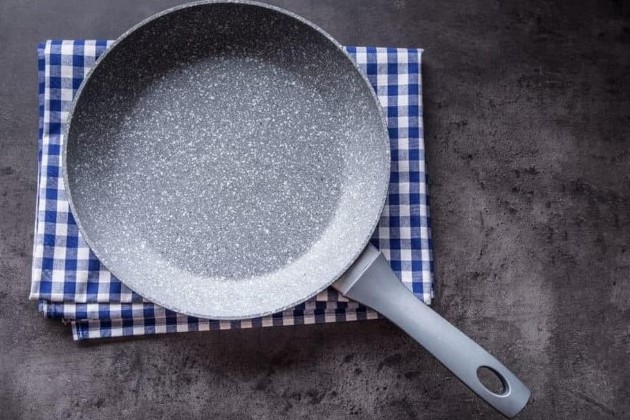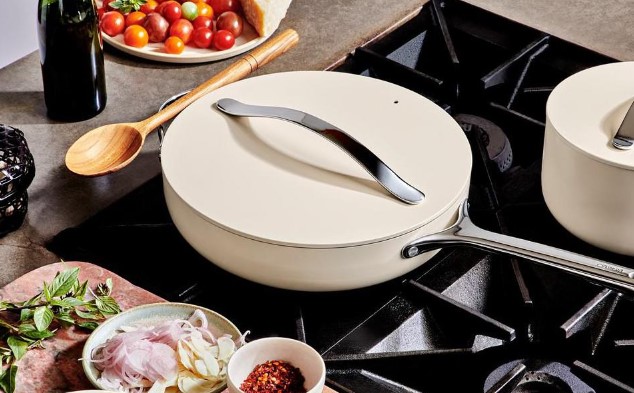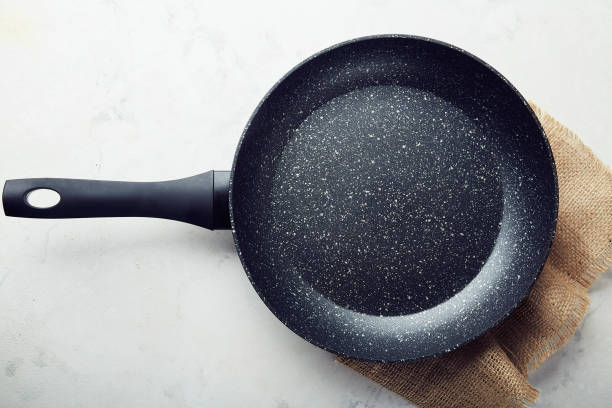In the world of culinary craftsmanship, the humble ceramic pan holds an esteemed position, renowned for its versatility and health-conscious appeal.
Yet, like any seasoned kitchen warrior, even the most beloved ceramic pan may start to lose its non-stick prowess over time, succumbing to the sticky residue of past culinary conquests.
Fear not, for reviving its slick surface and restoring its former glory is not just a possibility, but a deliciously satisfying endeavor awaiting the adept hands of any culinary aficionado.
Prepare to embark on a culinary restoration journey as we unveil the art and science of resurrecting your ceramic pan’s non-stick charm, ensuring every sauté and flip sings with effortless grace once more.

How To Make A Ceramic Pan Non Stick Again
Restoring a ceramic pan to its non-stick glory isn’t an overly complicated process, but it does require some care and attention to ensure you don’t damage the coating.
Here’s a step-by-step guide on how to make a ceramic pan non-stick again:
Step 1: Clean Your Pan
Step 1 in restoring the non-stick qualities of your ceramic pan involves thorough cleaning to remove any residue or buildup that may be compromising its performance.
Begin by washing the pan with warm water and mild dish soap, using a soft sponge or cloth to gently scrub the surface. Pay close attention to any areas with stubborn food particles or grease, ensuring they are effectively removed.
Avoid using abrasive cleaning tools or harsh chemicals, as these can further damage the ceramic coating. Rinse the pan thoroughly with water and dry it completely before proceeding to the next step.
A clean surface is essential for the success of subsequent restoration methods and will help ensure optimal results in rejuvenating your ceramic pan’s non-stick properties.
Step 2: Put Oil On Your Ceramic Pan
Step 2 in the process of restoring your ceramic pan’s non-stick qualities involves applying a thin layer of oil to the surface. Choose a high smoke point oil such as vegetable oil, canola oil, or grapeseed oil.
Using a paper towel or cloth, spread a small amount of oil evenly across the entire surface of the pan, including the sides. Make sure not to use too much oil, as a thin layer is all that’s needed to help rejuvenate the non-stick coating.
Once the oil is applied, heat the pan over low to medium heat for a few minutes to allow the oil to penetrate the ceramic surface. This step helps to condition the pan and create a protective layer that enhances its non-stick properties.
After heating, let the pan cool completely before wiping off any excess oil with a paper towel. Your ceramic pan is now ready for use, with its non-stick surface restored and ready to deliver excellent cooking results.
Step 3: Cover The Entire Surface With Oil
Step 3 involves thoroughly covering the entire surface of your ceramic pan with oil to aid in restoring its non-stick properties. Begin by heating the pan over low to medium heat to help the pores of the ceramic open up.
Once heated, pour a small amount of oil into the pan and use a paper towel or a brush to spread it evenly across the surface, ensuring every inch is covered. Take care to apply a thin, uniform layer of oil, avoiding excessive amounts that could lead to pooling or dripping.
Continue heating the pan for a few minutes to allow the oil to soak into the ceramic coating, aiding in its rejuvenation. Afterward, remove the pan from the heat and let it cool completely before wiping away any excess oil with a paper towel.
This step helps condition the ceramic surface, enhancing its non-stick capabilities and ensuring optimal cooking performance.
Step 4: Turn Up The Heat
Step 4 involves turning up the heat on your ceramic pan to a moderate temperature to aid in the restoration process. Once you have covered the entire surface with oil, gradually increase the heat to a medium-high setting.
This increase in temperature helps to bond the oil to the ceramic surface, creating a protective layer that enhances its non-stick properties. Allow the pan to heat up for a few minutes, ensuring that the oil is evenly distributed and absorbed by the ceramic coating.
Be cautious not to overheat the pan, as excessive heat can cause the oil to smoke or burn, potentially damaging the non-stick surface. After heating, allow the pan to cool completely before wiping away any excess oil with a paper towel.
This step helps to seal in the oil and further enhances the non-stick qualities of your ceramic pan, ensuring optimal performance for your cooking needs.
Step 5: Monitor Then Remove
Step 5 involves closely monitoring the ceramic pan as it heats up and then removing it from the heat once the desired temperature is reached.
Once you’ve turned up the heat to a moderate setting as in the previous step, keep a close eye on the pan to prevent overheating or burning of the oil. You want to heat the pan enough to allow the oil to bond to the ceramic surface without reaching temperatures that could damage the non-stick coating.
Once you notice the oil beginning to shimmer or see slight wisps of smoke, this indicates that the pan is adequately heated. At this point, remove the pan from the heat source promptly to prevent any further heating.
Allow the pan to cool down completely before handling it. This careful monitoring and timely removal ensure that the oil bonds effectively to the ceramic surface, enhancing its non-stick properties without causing damage.
Step 6: Wash Your Pan
Step 6 involves washing your ceramic pan after completing the restoration process to remove any excess oil and residue. Begin by allowing the pan to cool down to a safe temperature for handling.
Once cooled, wash the pan with warm water and mild dish soap, using a soft sponge or cloth to gently scrub the surface. Pay particular attention to areas where oil may have pooled or accumulated.
Rinse the pan thoroughly with water to ensure all soap and residue are removed. After washing, dry the pan completely with a clean towel or allow it to air dry.
Avoid using abrasive cleaning tools or harsh chemicals, as these can damage the non-stick coating you’ve worked to restore. With proper cleaning, your ceramic pan is now ready to be used again, with its non-stick surface rejuvenated and ready to deliver excellent cooking results.
What Makes Ceramic Pans Lose Their Non-Stick Qualities

Ceramic pans are popular choices in kitchens for their non-stick qualities and durability. However, like any cookware, they can lose their non-stick properties over time due to various factors:
Abrasive Cleaning
Using abrasive materials such as steel wool or harsh scouring pads can scratch the ceramic coating, leading to a decrease in its non-stick capabilities. It’s essential to use gentle cleaning tools like soft sponges or cloths to maintain the integrity of the ceramic surface.
High Heat
While ceramic pans can withstand high temperatures, excessive heat can cause the ceramic coating to degrade over time. This can result in the loss of its non-stick properties. It’s advisable to use low to medium heat settings for cooking with ceramic pans to preserve their non-stick surface.
Cooking Sprays and Oils
Some cooking sprays and oils can leave a residue on the ceramic surface, gradually diminishing its non-stick qualities. Over time, this buildup can become difficult to remove and affect the pan’s performance. Opting for cooking oils with high smoke points and using them sparingly can help prevent this issue.
Metal Utensils
Using metal utensils, such as spatulas or tongs, can scratch the ceramic coating, leading to a decline in its non-stick properties. It’s best to use utensils made of silicone, wood, or plastic to avoid damaging the ceramic surface.
Cooking Acidic Foods
Acidic foods like tomatoes or citrus-based dishes can react with the ceramic coating, causing it to deteriorate over time. While ceramic pans are generally resistant to acidic foods, prolonged exposure can weaken the non-stick surface.
Dishwasher Use
Although some ceramic pans claim to be dishwasher safe, frequent exposure to harsh dishwasher detergents and high temperatures can accelerate the breakdown of the ceramic coating. Handwashing with mild dish soap and warm water is recommended to prolong the lifespan of ceramic pans.
Wear and Tear
Like any cookware, ceramic pans will naturally wear out over time with regular use. Continuous cooking, cleaning, and exposure to heat can gradually degrade the non-stick properties of the ceramic coating, necessitating eventual replacement.
Season Your Ceramic Pan From Time To Time
Seasoning your ceramic pan from time to time can help maintain and even enhance its non-stick qualities. Similar to cast iron cookware, seasoning involves applying a thin layer of oil to the ceramic surface and heating it to create a protective layer.
This process helps fill in any microscopic pores in the ceramic coating, reducing the chances of food sticking and making cleanup easier. To season your ceramic pan, start by cleaning it thoroughly and drying it completely.
Next, apply a small amount of high smoke point oil, such as vegetable oil or grapeseed oil, to the surface of the pan and spread it evenly with a paper towel or cloth.
Heat the pan on low to medium heat for a few minutes to allow the oil to penetrate the ceramic surface, then let it cool completely before wiping away any excess oil.
Repeat this process periodically to maintain the non-stick properties of your ceramic pan and ensure it performs optimally with each use.
How Do You Take Care Of Your Ceramic Pans?

Taking care of your ceramic pans is essential to ensure their longevity and optimal performance. Here are some tips for maintaining and caring for your ceramic pans:
Use Gentle Cooking Utensils
Avoid using metal utensils that can scratch the ceramic coating. Instead, opt for utensils made of silicone, wood, or plastic to prevent damage.
Avoid High Heat
While ceramic pans can withstand moderate heat, it’s best to cook on low to medium heat settings to prevent the ceramic coating from degrading over time. High heat can cause the non-stick properties to deteriorate faster.
Hand Wash Only
While some ceramic pans claim to be dishwasher safe, hand washing is generally recommended to prolong their lifespan. Use mild dish soap and warm water to clean the pan, and avoid abrasive cleaning tools that can scratch the surface.
Season Periodically
Seasoning your ceramic pan from time to time can help maintain its non-stick qualities. Apply a thin layer of high smoke point oil to the surface of the pan and heat it to create a protective layer.
Avoid Cooking Spray
Cooking sprays can leave a residue on the ceramic surface, reducing its non-stick properties over time. Instead, use a small amount of oil or butter to grease the pan before cooking.
Store Properly
Store your ceramic pans carefully to prevent scratching or damage. Avoid stacking heavy items on top of them, and consider using pan protectors to cushion them if you need to stack pans in a cupboard.
Inspect Regularly
Periodically inspect your ceramic pans for signs of wear and tear, such as scratches or chips in the coating. If you notice any damage, consider replacing the pan to maintain optimal cooking performance.
By following these care tips, you can prolong the lifespan of your ceramic pans and ensure they continue to provide excellent non-stick performance for years to come.

Frequently Asked Questions (FAQs) – How To Make A Ceramic Pan Non Stick Again
What’s the best way to restore the non-stick surface of my ceramic pan?
We’ve got you covered! We recommend using natural remedies like baking soda and vinegar, or specialized non-stick seasoning products. These methods are effective and eco-friendly.
Can I still salvage my ceramic pan if it’s lost its non-stick properties?
Absolutely! With the right techniques and care, you can revive your ceramic pan’s non-stick surface and bring it back to its former glory. It’s all about giving it some TLC.
Are there any DIY methods that won’t harm my ceramic pan?
Yes, indeed! Our recommended DIY methods are safe for your ceramic pan and won’t cause any damage. From gentle scrubbing with baking soda to seasoning with cooking oil, these techniques are both effective and gentle.
Is it possible to make my ceramic pan non-stick again without using harsh chemicals?
Definitely! We advocate for natural and non-toxic solutions to restore your ceramic pan’s non-stick properties. You can achieve impressive results without resorting to harsh chemicals that might compromise your health or the environment.
How long will it take to make my ceramic pan non-stick again?
Patience is key, but fear not! While the time required may vary depending on the severity of the situation, you can expect noticeable improvements with just a little effort and some time dedicated to the process. It’s a small investment for a big payoff in the kitchen!
Will restoring the non-stick surface of my ceramic pan affect its performance?
Restoring the non-stick surface of your ceramic pan will actually enhance its performance! A rejuvenated non-stick coating means effortless cooking and easy cleanup, making your culinary adventures even more enjoyable.
Can I use my newly restored ceramic pan on all types of stoves?
Absolutely! Once you’ve revived the non-stick surface of your ceramic pan, it’ll be ready to shine on any type of stove – gas, electric, induction, you name it. Get ready to cook up a storm without any limitations!
How frequently should I perform maintenance to keep my ceramic pan non-stick?
Consistency is key to maintaining the non-stick properties of your ceramic pan. We recommend incorporating regular cleaning and seasoning into your cooking routine to ensure long-lasting performance and effortless cooking every time.
Are there any additional benefits to making my ceramic pan non-stick again?
Certainly! Besides the obvious advantage of easier cooking and cleaning, restoring your ceramic pan’s non-stick surface can prolong its lifespan, saving you money in the long run. Plus, it’s a rewarding DIY project that’ll leave you feeling accomplished in the kitchen!
Where can I find more tips and tricks for restoring my ceramic pan’s non-stick surface?
Look no further! We’ve curated a wealth of resources and guides to help you revive your ceramic pan’s non-stick properties effortlessly. Stay tuned for more expert advice and kitchen hacks to elevate your cooking experience.
Conclusion
In conclusion, revitalizing a ceramic pan to restore its non-stick properties is a practical and sustainable approach to extending its lifespan and ensuring continued culinary enjoyment.
By employing simple yet effective techniques such as seasoning, cleaning with gentle methods, and avoiding high heat, users can breathe new life into their ceramic pans, reclaiming their non-stick functionality and culinary utility.
With careful maintenance and attention to detail, these pans can serve as reliable kitchen companions for years to come, offering both environmental and economic benefits.
Embracing these practices not only enhances cooking experiences but also underscores the value of mindful stewardship of kitchen tools in promoting sustainability and resourcefulness in our daily lives.
Other Articles You May Also Like: